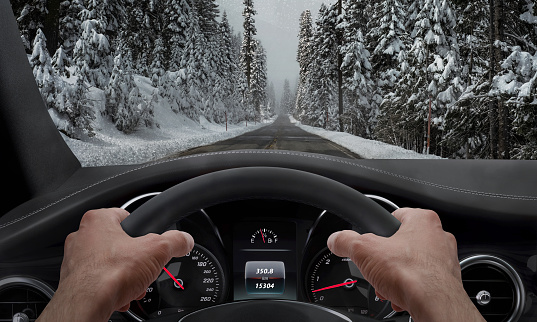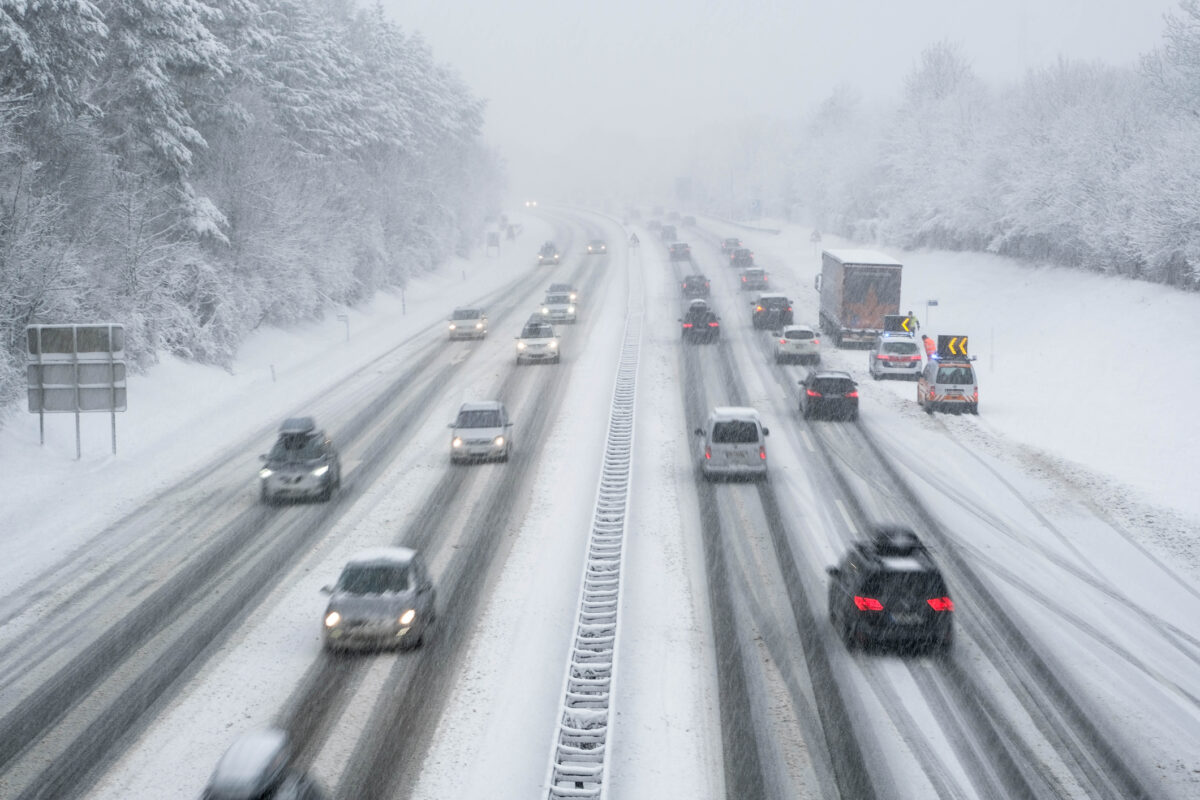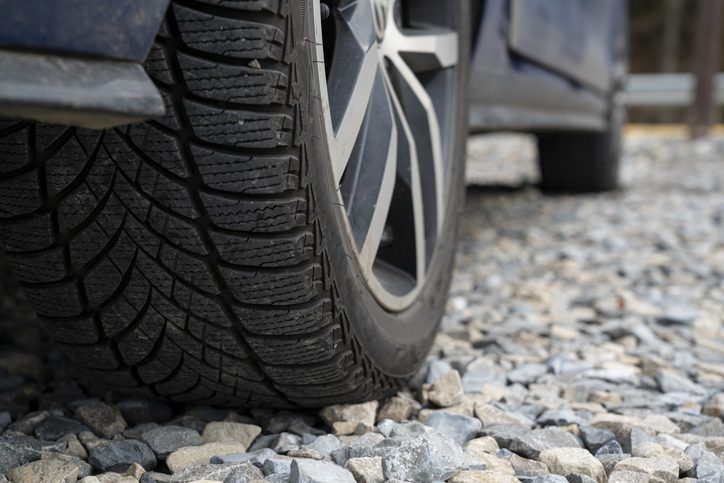Winter driving can be dangerous, especially in the snowier parts of the country. According to the Federal Highway Administration, more than 1,300 people are killed, and over 116,800 are injured, in vehicle crashes due to snowy, slushy or icy pavement every year.
When it comes to driving in severe weather, your best move is simply to avoid it. But, if you have to, following these winter driving tips can help keep you safer on the road.
Tips for Safe Winter Driving
Maintain Distance
In normal driving conditions, you should maintain at least three seconds of distance from the car in front of you. In winter driving conditions you should expand this to least eight to 10 seconds of distance. This will help ensure that you can brake in time to avoid any collisions if other cars stop or slow down abruptly.
Drive for the Conditions
Speed limits are based on perfect road conditions. In winter driving conditions, going 65 mph on the highway can be fatal. Use your judgment and reduce speed to what you think is safe. Also, don’t feel pressured by a driver behind you who is tailgating or flashing their lights. You know what’s safest for you. If necessary, pull to the side of the road to let the driver pass.
Respect Snowplows
Keep a distance of at least 70 feet (four car lengths) behind a snowplow. This will help ensure that you are not in one of the plow’s blind spots. It can also help keep the sand spraying from the back of the plow from damaging your vehicle. Also, never pass a plow. It is frustrating when they drive under 35 mph, but parts of the road they have not yet cleared may be unsafe.
Don’t Use Cruise Control
Cruise control can help improve your fuel economy but it’s dangerous to use in snowy conditions. Cruise control keeps your car traveling at a consistent speed. If your vehicle loses traction on a patch of ice, cruise control will accelerate to try to maintain speed.
Know When to Stay Off the Road
Aside from a travel ban, there is no specific rule to determine when you should and shouldn’t drive in the snow. A recommendation, though, is to check the forecast for all the areas that you’ll be driving through. Be sure to check the weather for the time you’re expecting to be on the road. Winter snow conditions can change very quickly. You don’t want to get caught in heavy snows during a long commute.

You should also make sure that your vehicle is ready for the winter weather. The following section will help you learn how to maintain your vehicle in the winter months.
Vehicle Maintenance Tips for Better Winter Driving
Check Your Tire PSI
Your tires will deflate one PSI for every 10° drop in temperature. Under inflated tires can decrease vehicle handling and brake response time. Check your tires’ PSI using a digital tire pressure gauge and keep them inflated to the correct PSI during the cold winter months. You can find the correct PSI for your vehicle’s tires in your owner’s manual. There should also be a sticker that states your vehicle’s correct tire PSI in the driver’s side door jam or glove compartment.
Clean Your Car After Snowfall
In some states you may get a ticket for driving a vehicle without clearing the snow off first. Failing to do so is not only dangerous for you but for other drivers on the road. Uncleared snow can fly off your car while driving and hit another vehicle. Always clear all parts of the car before driving. This includes the roof and hood but also all the windows, lights and mirrors.
Keep Your Gas Tank at Least Half-Full
It’s possible for condensation to form in the empty part of your gas tank. In cold winter months this condensation can freeze. The frozen condensation can then block your fuel line. This blockage can prevent your vehicle from starting or running properly. Be sure to keep your gas tank at least half-full during the winter.
Mix the Correct Antifreeze
The right mixture of antifreeze can keep your car running in the wintertime. It can also increase the lifespan of your engine block. A 50/50 water/antifreeze mix is often recommended, but check the labeling on the antifreeze bottle first. Using more antifreeze will not help protect your car in the colder months. Instead, it can destroy your engine block. Also, make sure that your windshield wiper fluid is treated to handle the winter months as well. You may need to add anti-freeze fluid based on the temperatures you are expecting.
Check Your Tire Treads
You’ll need all the traction you can get to handle your car in winter driving conditions. Check your tires by placing a penny with Lincoln’s head, upside down and facing you, in the tread. If you can see Lincoln’s entire head then there isn’t enough tread on your tires and you should replace them.
Stay Warm if Your Vehicle Breaks Down in the Winter
Immediately bundle up with as many layers as possible. You can run the heater but only if you know the tailpipe of your car is not obstructed by snow. If it’s safe for you to get out of your vehicle, you can do so to check the tailpipe and clear snow out of the way if needed.
Additional Considerations for Safe Winter Driving
It’s best to stay off the roads during a snowstorm. But if you must travel, be sure to follow the winter driving and maintenance guides outlined in this article, plus these tips:
- Maintain your vehicle so that it can handle the winter months. If you don’t feel comfortable making these adjustments, ask a mechanic.
- Review your car insurance coverage. If you do need to file a claim, someone from your insurance company will guide you through the process. However, you’ll feel better if you already have an idea of what type of damage may or may not be covered.
- Remove your shovel, scraper, and other snow-removal supplies from your trunk. You won’t be able to get to them if there’s a foot of snow on top of your car.
- Storing some extra floor mats or old towels in your car can help you drive out of a spot you’re snowed into. Just place them on the snow beneath your tires for added traction. A stash of ice melt can help too.
- Be prepared in case you get stuck in a storm. Make sure to have your car stocked with an emergency kit, including first aid, snacks and items to keep you warm, should you ever need them.
- Ready.gov provides guidelines for what to do if you get trapped in your car during a winter storm – e.g. turn on the engine and heater for ten minutes each hour to stay warm, and remain in your vehicle unless you know there’s a building very close to you – as well as other severe weather tips.
- Make sure your tires are ready. Investing in snow tires can be a life-saving decision, especially for those who experience stormy winters.
- Ensure there are no road closures, local or state travel restrictions, or traffic-snarling accidents along your route.
- Park your car in a safe spot when possible after arriving at your destination. For example, not underneath a dead tree or one full of snowy limbs.
Not sure where to start? Download our Emergency Evacuation Checklist here.







Thanks for all the helpful winter driving information especially the one on checking tire pressure during the cold months.
Good information about leaving your gas tank half full.
no job is worth getting into an accident for! if you leave early in the morning i would wait too leave two hours later because roads were usually plowed and sanded by then. a 4-wheel drive auto also helps. if snow is too deep- stay home!!
It’s always iciest on bridges and at stop signs and traffic lights, use caution in these areas.
Thank you for this information….very helpful.
I keep supplies in my trunk year round.
Blanket
Scarf
Gloves
Water
Granola Bars – replace a couple of times a year
A large container (in case you’re stuck in the car for a loooong time)
Just in case something happens you have this equipment readily available.
When coming to a red light or any stop at an intersection where it tends to ice up, I always pop my car into neutral to take the pull off the engine and make it easier on the brakes. Also for emergency quick stops. Also, when taking off when the light turns green, I put it in low to start out to eliminate spinning tires, and tail spinning. Once you’ve started moving put it back in Drive.
Yes I liked that you sent that to us. I always clear my roof of car and the tail lights windows before driving. That way good for me and other drivers.
My thing is if the weather is real bad don’t drive it’s not worth your life. A car you can replace a life no or injurys s
If you go into a skid, look at where you want to go — not at the obstacles you need to avoid.
Advice for electric vehicles (EVs)?
Always keep warm throws in the car in the winter in case you can’t keep driving. Buy a few of those very cheap sheets of (Kevlar?) that you see being given to homeless immigrants on the news. On a cross-country road trip one summer, we suddenly ran into some very cool temperatures. We were dressed for warm summer weather, and I was freezing. I happened to have some of those sheets in my glove box and I decided to try one. I was amazed to learn how effective they are at maintaining your body heat.
When driving on snowy, slippery roads,, drive slowly enough that you will never have to slam on your brakes, which will put your car in a spin. If you have to brake, do so by gently pumping your brake pedal to avoid fish-tailing or spinning out of control.
If you get stuck in deep snow, STRAIGHTEN YOUR TIRES and go gently in reverse. When you can no longer go in reverse, KEEP THE TIRES STRAIGHT and go gently forward. Rocking your car gently backward and forward may help you get unstuck so that you can continue driving. Spinning your tires will sink them more deeply into the snow.
If the roads are really bad, find a place where you can safely park to wait for driving conditions to improve. Being delayed is always a pain, but it could be a lot worse.
I always recommend having a roadside assistance service like AAA whom you can call in the event of a flat tire, a dead battery, or the need of a tow. It is a once-a-year cost, and is worth every penny. If you have kids who drive, they can be added to your plan at a lower rate.
I posted this, but what I do is put my car into neutral when coming to a stop in the snow or on ice. Its way better than pumping the breaks.. it takes the pull off the car and makes it easier on the breaks. Also put it in low when taking off
Nice and helpful safety tips, thank-you.
Excellent advise on winter driving preparedness. In our car, in the winter, I keep some water, apple juice, crackers, canned tuna, dry cereal, etc… things to snack on if I should get stuck, along with a blanket. Like insurance, I keep it, and hope I’ll never need to use it.
THANKS!!!
Keep a bag of kitty litter in your vehice. It’s great for icy spots if you get stuck
Great tips, hope everybody follows them!
Thank you Hartford for the reminders of winter driving. One more suggestion is to keep a couple of blankets/coats in vehicle just in case that you get caught up in traffic stopped due to weather conditions.
A fantastic tip! Thanks, John!
The most important is a good set of all weather tires. A lot of the new cars come with highway tread & are not as good on wet & snowy roads. Also, slow down when weather is bad.
Good information to refresh on winter driving and m,aintenance.
THANK YOU!!!!
Good reminders for safe winter driving. Thank you. Also remember to steer into a skid and pump brakes to slow down on icy or slick roads.
So much for voice, recognition I meant to say anti-lock,brakes but again, go to a large parking lot like a mall with no other cars around that is covered with snow and ice drive to about 30 miles an hour and then slam on the brakes and steer around it. If you have a traffic cone, bring that out and put it in the parking lot and drive toward it slam on the brakes and see if you can steer around it practice that a few times I taught my kids to do that and it is a very important lesson. Also add road coverage on your insurance so in case you do get stuck and can’t get out you can always get a tow truck that the insurance company will usually provide for you at no charge and get you on your way
Thanks for all the information.😂🍀
Make sure that you do not pump your brakes if you find that you’re in a skid because that defeats the analog brakes, analog brakes help you by rotating the tire as you break. Also go to an empty parking lot that has ice and snow on it and drive at a normal speed and slam on the brakes and try to steer so you know exactly, how the corresponds and your anal breaks will respond do that a few times and you’ll know what to expect when you slam on the brakes to avoid an accident
Very good advice, please include me in your comments. Thank you Tom!
Snow tires are a must (in my opinion) for winter driving. While all season tires are good in rain, snow tires are best in snow/ice. Having snow tires on is like wearing hiking boots as opposed to sneakers on the trail. I worked in a hospital and HAD to get to work. Most times the snow plows were not out very early on the weekends so I was on my own. I drove through many really bad storms and I believe the snow tires saved my life many times. I watched other SUV’s slide off the road because they did not have adequate traction. Doesn’t matter if you are driving an SUV, it’s the tires that make a difference.
Thank you for the reminders.
Thank you! Be safe everyone!
Also keep some snacks in your car and a beverage. It will provide energy and make you feel better if you have to stop for a long time.
Check out the route you’re going to travel even if it’s just across town and don’t talk on your cellphone while driving, pull over and stop then answer your call. Many accidents happen because of cellphone conversations or direction location searching.
Carry water, a sleeping bag, and a jar of peanut butter in case you are stranded.
For goodness sake, and your own, PLEASE use your headslights and all lights you can illuminate. Maybe you have superior vision but it’s not all about you seeing, it’s about others seeing you. I promise you won’t wear out your lights. I am shocked at the number of people that won’t use their lights after sundown. They are a menace!
Thank You
What is the optimum thermostat setting for my Ford focus in the winter time?
Hi Kathleen! We recommend reaching out to your dealer specifically, but based on our research anywhere between 68°F (20°C) and 72°F (22°C) is ideal for cars.
Check your windshield wipers!
THANK YOU, GREAT ADVICE! EVERYONE COULD USE A REFRESHER COURSE LIKE THIS.
The most important thing in winter driving are the tires, plus the experience of the driver of course. Rubber composition and tread design are a key factor. You need tires designed for blizzard conditions, such as Blizzaks or studless tires. They are made of soft rubber with sipes in the aggressive tread for grip. These tires are only for winter use, as they will wear quickly on hot dry pavement. Use the transmission gears to slow the vehicle down when appropriate. Never lock up the wheels during braking, that is worst thing that you can do on ice. I do not recommend studded tires, they clog with snow. Antilock brakes are not good on icy roads. They temporarily lock the wheel and you will lose grip and possibly losing control of the vehicle. Always turn the wheel in the direction of the skid and adjust as necessary. There again, Experience in icy conditions. Speed is another factor keep it down, Silly.
How do you stop your windshield wipers from freezing up when driving in snowing conditions?
Because modern cars have sunken wipers that sit in a pit behind the hood, this has become more of a problem than with older cars. Buy a car that has de-icer wires built into the windshield in the area of the wiper blades. Also buy a car that has a full-width defrost air vent in the dashboard. Clean the snow out the wiper pit at the back of the hood and clean the snow off of all of the hood before driving. Also, spray the wiper blades with aerosol de-icer. If needed while driving, pull off to a safe area and repeat these actions. At that time, pull up on the wipers and let them slap down onto the windshield to break off snow and ice. Use winter-type wiper blades, which shed snow and ice. Run the defroster at full heat and speed. Use soft items like mittens to deflect defrost air down and across the windshield.
What do you do when you hit black ice and your car goes all around the road? Do you turn your wheel into the skid or is it just the opposite?
Assuming that you have anti-lock brakes, as all modern cars do, stomp-and-stay on the brakes to generate whatever stopping action the car can achieve while steering in the direction that you want the car to go, which may be either to avoid something, like another car, or pulling over onto the shoulder, or to getting back into the lane (on the correct side of the road). When driving in tricky conditions, it’s a good idea to have already thought through what you’ll do if things suddenly go badly.
I actually had this situation once long ago. I didn’t have time to think so in order to not go off the road (short drop on each side) my reaction was to turn the wheels in the opposite direction of the drop off, while not braking, and it finally straightened out. My co-worker who was behind me said I did a good job but again it was a reaction. Hope you never experience it because it is scary
Good info
The correct response is to steer into the skid, aligning the wheels of your steering axel with the direction you wish to travel in. Tap your brakes very gently, never hold down. Holding down on the brakes will place you into a life threatening uncontrolled skid/spin. By gently tapping and releasing the brakes, you will lessen momentum and eventually regain traction and control. You will need to compensate your steering to maintain direction. Never rely on ABS to save your life. It wasn’t designed for icy condition, just wet roads.
I agree, all of this is a good refresher to read. Thanks to All! Be Safe & Happy Holidays!